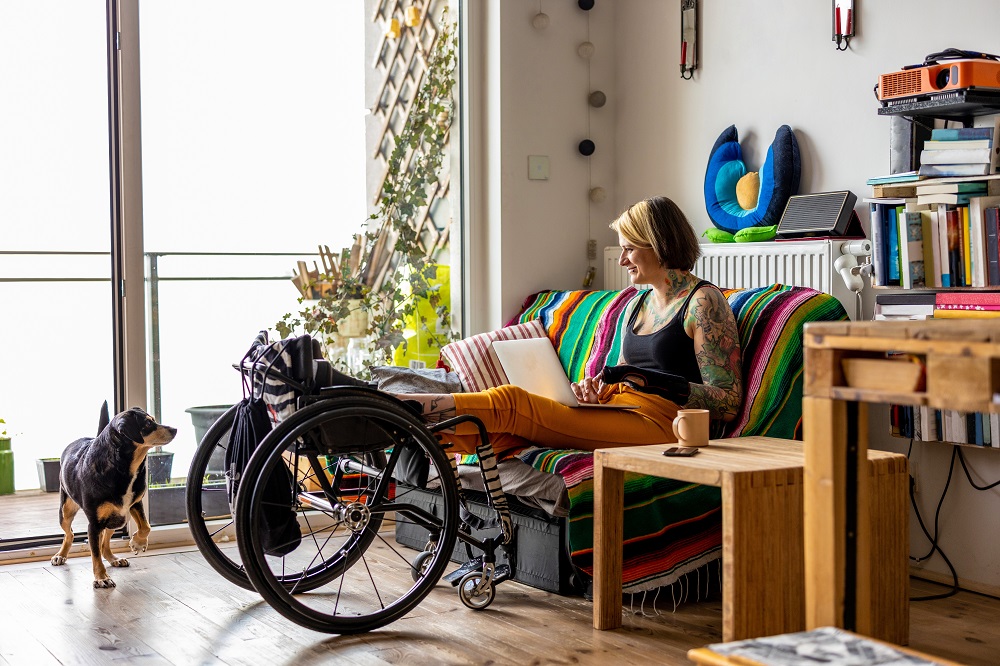Independent Living and Mobility Equipment – Fostering a Supported Home Environment

For many people with disability, achieving independence is one of the most important goals in life. Of course, disability takes on many forms, so unfortunately there is no one-size-fits-all approach to achieving this goal. While some people will require higher levels of assistance than others, it’s important to many people to work out a plan that utilises the best range of independent living options (ILO) to strike the best possible balance between assisted living and complete independence.
What Are Independent Living Options (ILO)?
At St. Jude’s, we strive to meet the diverse needs of those living with disabilities by offering NDIS-approved independent living options. Our ILO model provides you with personalised, formal or informal support, enabling you to live independently based on your individual requirements and preferences. Independent living gives you the freedom to live alone or with companions of your choice, such as a partner, friend, family member, support worker, or host family. ILO is often combined with the use of asstistive technologies to further aid with independence.
There is a great range of daily living aids (assistive technologies) that are available to help people with limited mobility to perform basic daily tasks both inside the home and out. Use of assistive technologies can greatly reduce the need for higher levels of support from a professional support worker. In some cases these ILOs can bring a client’s support requirements down to just a quick daily drop-in rather than round the clock care.
What Are Some Examples Of Disabilities That May Require The Use Of Mobility Equipment Or Assistive Technology?

Anybody with a temporary or long-term mobility issue can benefit from mobility aids. Some examples include:
- Amputation
- Arthritis
- Cerebral palsy
- Developmental disabilities
- Diabetic ulcers and wounds
- Difficulties maintaining balance
- Fractures or broken bones in the lower limbs
- Gout
- Heart or lung issues
- Injury to the legs, feet, or back
- Limited mobility due to age
- Obesity
- Spina bifida
- Sprains and strains
- Walking impairment due to brain injury or stroke
- Visual impairment or blindness
What Kinds Of Aids Are Available For People With Disability?
There is a wide range of independent living aids for customers who require some form of assistance, but for the moment, we’ll focus mostly on devices that help people with limited mobility.
Wheelchair
People who are still able to walk short distances may be reluctant to use one, but a wheelchair can mean the difference between being house bound and being able to attend family and other social functions, as well as carry out daily tasks like shopping. They’re useful for people with lower leg issues right through to severe disability and can help those who need them to continue to access the community.
Walking frame
One of the most commonly prescribed mobility aids, walking frames have many benefits, including:
- Providing stability for those suffering from decreased balance, helping to prevent falls
- Extra support for those who become short of breath while walking
- Most come with seats, providing a surface to rest on if required
- Maintain and improve community access, even if just for outdoor mobility
- A basket to hold items g. shopping or handbags
- Help to increase walking distance
- Easy to use safety brakes
Walking frames come in a large range of styles and with different wheels to suit the desired application.
Mobility scooter
Similar to a wheelchair, mobility scooters have a seat on top of either three, four, or five wheels. They are powered electrically and are easy to control, as well as being comfortable for the user. Mobility scooters are an excellent piece of equipment for helping people with mobility issues get back into community and family activities as well as running personal errands.
Toilet seat raiser
The low height of a toilet seat and the absence of anything to hold or push up from means they pose a significant fall risk for people with mobility issues. A toilet seat raiser increases the height of the surface as well as providing arm rests to push up from, helping to alleviate this problem. They are adjustable, can be fitted for all heights and are especially beneficial for patients who have had hip replacements or spine surgery and are unable to bend their hips beyond 90 degrees.
Shower stool
The hard wet floor of a shower can be dangerous for people with mobility issues, so a shower stool can be a handy tool to make showering safer and easier.
Wheeled shower commode
This device can be used as a commode, over toilet frame and a shower chair. For people who can’t walk into the bathroom but still want a proper shower, they can transfer onto the chair, be wheeled over the toilet and then into the shower. It has brakes for safety, so it won’t move when you’re sitting down or standing up.
Grab rails
These are usually installed in showers, toilets and alongside stairs to help people get up and down, and to provide extra support. It’s important that they are professionally installed as they need to be able to support your full body weight.
How Do People Access Mobility Aids and Assistive Technologies Through The NDIS?
NDIS occupational therapists and NDIS physiotherapists are trained to prescribe independent living and mobility equipment, as long as it is outlined in your NDIS plan. Their services are available through your NDIS services provider, and once your mobility aids or assistive technology have been approved, they can be purchased through your NDIS funding.
Get In Touch With Us At St Jude’s
As one of Australia’s most trusted disability support services providers, St Jude’s is dedicated to helping people receive the support they need to enjoy a fulfilling and independent life. To find out more, explore our website or give us a call and speak with any of our helpful team.
|
|


